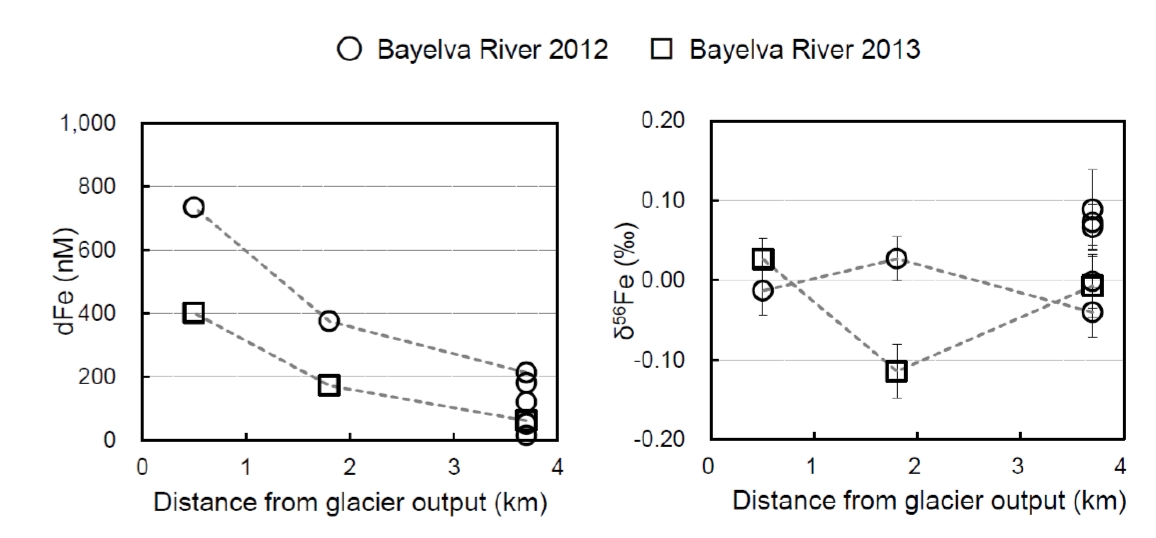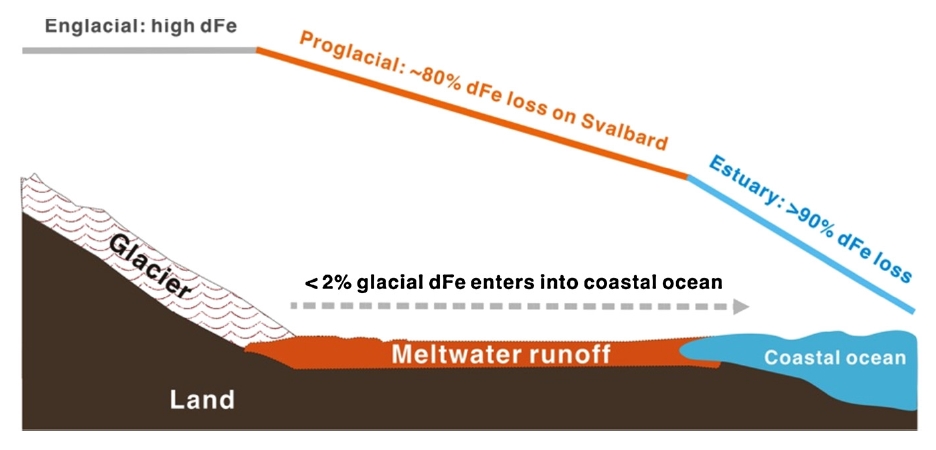Transport and reaction of iron and iron stable isotopes in glacial meltwaters on Svalbard near Kongsfjorden: From rivers to estuary to ocean
Glacial meltwater has been suggested as a significant source of potentially bioavailable iron to the oceans. However, the supply of dissolved iron (dFe) in glacial meltwaters is poorly constrained as few sites have been studied, and because the chemical processing of Fe during transport from glaciers to the adjacent coastal ocean is not well understood. In order to better constrain glacial fluxes of dFe to the ocean, iron concentrations, iron stable isotopes (δ56Fe), and other supporting chemical and physical measurements were made along a ∼4km long glacial meltwater river on Svalbard and in estuarine waters that it flows into. Dissolved iron concentrations in the Bayelva River decreased from a maximum of 734 nM near the glacier to an average value of 116nM near the mouth of the river. Measurements in the Kongsfjorden estuary suggest that 3 to 10nM of dFe from the Bayelva River is stabilized in glacial waters by the time it mixes into the ocean. Incubation of Bayelva River waters over two weeks in both the light and dark show similar results, with the majority of dFe being quickly precipitated and 4 to 7nM Fe stabilized in the dissolved phase. Evidence suggests that Fe is most likely lost from the dissolved phase by aggregation and adsorption of nanoparticulate and colloidal Fe to particles. Dissolved δ56Fe was between −0.11‰ and +0.09 ‰ for all river samples and did not vary systematically with dFe concentrations. We infer that the Fe is lost from the dissolved phase by a process that fractionates Fe isotopes by less than 0.05 ‰, indicating that the Fe bonding environment does not change during precipitation. This is consistent with DOC loss that is much faster than predicted photo-oxidation rates, suggesting that DOC is also lost through adsorption and precipitation. Dissolved Fe concentrations in the Bayelva River (15–734nM), and Fe concentrations which are stabilized in the dissolved phase (4–7nM) are much lower than some previous estimates of Fe in glacial meltwaters, with roughly 80% of dFe lost during transit in the Bayelva River and roughly 90% of the remaining dFe lost in the estuary. This may mean that glaciers are a less significant source of dissolved Fe to the global oceans than has been previously hypothesized, that cold base glaciers of the type studied here do not contribute significantly to the dissolved Fe flux, or that the flux of reactive particulate Fe to the oceans is more important than the dissolved flux. In Arctic regions with similar proglacial environments, bedrock composition, weathering intensity, and as precipitation of colloidal and nanoparticulate Fe may all play an important role in regulating the glacial meltwater iron flux to the ocean.
Fig. 1. Dissolved Fe (dFe) concentrations, δ56Fe values, and ancillary parameters including pH, dissolved Mn (dMn), dissolved oxygen (DO), dissolved organic carbon (DOC), and total suspended matter (TSM) in the Bayelva River. Open circles represent data from 2012 and open squares represent data from 2013. Dashed grey lines connect data from samples taken during the same day.
Fig. 2. SchematicdiagramofdFetransportationfromglaciertocoastaloceanonSvalbard.
相关成果在Earth and Planetary Science Letters上发表,全文见:
-
Earth and Planetary Science Letters ,
2015 ,
424
: 201-211


